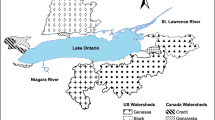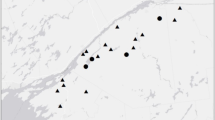Abstract
The biogeochemistry of Hg was evaluated in a small wetland in the Adirondack region of New York. Concentrations of total Hg (HgT) in streamwater draining the wetland showed little temporal variation. The annual areal watershed flux of HgT (2.2 µg/m2-yr) was considerably smaller than regional inputs of atmospheric deposition of HgT, indicating that the terrestrial environment is a net sink for atmospheric deposition of HgT. Drainage inputs of HgT were conservatively transported through the beaver impoundment. The annual flux of total methyl mercury (CH3Hg+ T was greater than literature values of atmospheric deposition suggesting that the watershed is a net source of CH3Hg+ T . Stream concentrations of CH3Hg+ T increased during low-flow summer conditions in a riparian wetland, and particularly at the outlet of the beaver impoundment. Net production of CH3Hg+ T occurred in the beaver impoundment (0.45 µg/m2-yr). Rates of net methylation for the beaver impoundment were comparable to values reported in the literature for wetlands.
Similar content being viewed by others
References
Bishop K, Lee Y-H, Pettersson C & Allard B (1995) Terrestrial sources of methylmercury in surface waters: The importance of the riparian zone on the Svarterget catchment. Water Air Soil Poll. 80: 435–444
Bloom NS (1989) Determination of picogram levels of methylmercury by aqueous phase ethylation, followed by cryogenic gas chromatography with cold vapour atomic fluorescence detection. Can. J. Fish. Aquat. Sci. 46: 1131–1140
Branfireun BA, Heyes A & Roulet NT (1996) The hydrology and methylmercury dynamics of a Precambrian Shield headwater peatland. Water Resour. Res. (in press)
Burke J, Hoyer M, Keeler G & Scherbatskoy R (1995) West deposition of mercury and ambient mercury concentrations at a site in the Lake Chaplain Basin. Water Air Soil Poll. 80: 353–362
Cirmo CP & Driscoll CT (1993) Beaver pond biogeochemistry: acid neutralizing capacity generation in a headwater wetland. Wetlands 13: 277–292
Cirmo CP & Driscoll CT (1996) The impacts of a watershed CaCO3 treatment of stream and wetland biogeochemistry in the Adirondack Mountains. Biogeochemistry 32: 265–297
Driscoll CT & van Dreason R (1993) Seasonal and temporal patterns in the chemistry of Adirondack lakes. Water Air Soil Poll. 67: 345–365
Driscoll CT, Wyskowski BJ, Cosentini CC & Smith ME (1987a) Processes regulating temporal and longitudinal variations in the chemistry of low-order woodland streams in the Adirondack Region of New York. Biogeochemistry 3: 225–241
Driscoll CT, Yatsko CP & Unangst FJ (1987b) Longitudinal and temporal trends in the water chemistry of the North Branch of the Moose River. Biogeochemistry 3: 37–62
Driscoll CT, Yan C, Schofield CL, Munson R & Holsapple J (1994) The mercury cycle and fish in the Adirondack lakes. Environ. Sci. Technol. 28: 136A–143A
Driscoll CT, Blette V, Yan C, Schofield CL, Munson R. & Holsapple J (1995) The role of dissolved organic carbon in the chemistry and bioavailability of mercury in remote Adirondack lakes. Water Air Soil Poll. 80: 499–508
Electric Power Research Institute (EPRI) (1994) Mercury Atmospheric Processes: A Synthesis Report. EPRI Report No. TR-104214
Engstrom DR, Swain EB, Henning TA, Brigham ME & Brezonik PL (1994) Atmospheric mercury deposition to lakes and watersheds. In: Baker LA (Ed) Environmental Chemistry of Lakes and Reservoirs. ACS Advances in Chemistry Series No. 237 (pp 33–66). American Chemical Society, Washington, DC
Fitzgerald WF, Mason RP & Vandal GM (1991) Atmospheric cycling and air-water exchange of mercury over mid-continental lacustrine regions. Water Air Soil Poll. 56: 745–768
Gilmour CC, Henry EA & Mitchell R (1992) Sulfate stimulation of mercury methylation in freshwater sediments. Environ. Sci. Technol. 26: 2281–2287
Hammerson GA (1994) Beaver (Castor canadensis): Ecosystem alteration, management and monitoring. Natual Areas J. 14: 44–xx
Hartman G (1994) Long-term population development of a reintroduced beaver (Castor fiber) population in Sweden. Conserv. Biol. 8: 713–717
Hecky RE, Ramsay DJ, Bodaly RA & Strange NE (1991) In: Suzuki T et al. (Eds) Advances in Hg Toxicology. Plenum Press, New York
Hudson RJM, Gherini SA, Fitzgerald WF & Porcella DB (1995) Anthropogenic influences on the global mercury cycle: a model-based analysis. Water Air Soil Poll. 80: 265–272
Johnston CA & Naiman RJ (1990) Aquatic patch creation in relation to beaver population trends. Ecology 71: 1617–1621
Johansson K, Aatrup M, Anderson A, Brinkman L & Iverfeldt A (1991) Mercury in Swedish forest soils and waters – assessment of critical load. Water Air Soil Poll. 56: 276–281
Krabbenhoft DP, Benoit JM, Babiarz CL, Hurley JP & Andren AW (1995) Mercury cycling in the Allequash Creek Watershed, Northern Wisconsin. Water Air Soil Poll. 80: 425–433
Lee U-H & Hultberg H (1990) Methylmercury in some Swedish surface waters. Environ. Toxicol. Chem. 9: 833–841
Lee Y-H & Iverfeldt A (1991) Occurrence and turnover of atmospheric mercury over the Nordic countries. Water Air Soil Poll. 25: 391–400
Lee Y-H, Borg GC, Iverfeldt A & Hultberg H (1994) Fluxes and turnover of methylmercury pools in forest soils. In: Watras CJ & Huckabee JW (Eds) Mercury Pollution Integration: and Synthesis (pp 329–342) Lewis Publishers, Boca Raton, Florida
Lee Y-H, Bishop K, Pettersson C, Iverfeldt A and Allard B (1995) Subcatchment output of mercury and methylmercury at Svartberget in northern Sweden. Water Air Soil Poll. 80: 455–465
Mason RP, Fitzgerald WF & Morel FMM (1994) The biogeochemical cycling of elemental mercury: anthropogenic influences. Geochim. Cosmochim. Acta 58: 3191–3198
Mierle G & Ingram R (1991) The role of humic substances in the mobilization of mercury from watersheds. Water Air Soil Poll. 56: 349–357
Rudd JWM (1995) Sources of methyl mercury to freshwater ecosystems: a review. Water Air Soil Poll. 80: 697–713
St. Louis VL, Rudd JWM, Kelly CA, Beaty KG, Bloom NS & Flett RJ (1994) Importance of wetlands as sources of methylmercury to boreal forest ecosystems. Can. J. Fish. Aquat. Sci. 51: 1065–1076.
St. Louis VL, Rudd JWM, Kelly CA & LA Barrie (1995) Wet deposition of methylmercury in northwestern Ontario compared to other geographic locations. Water Air Soil Poll. 80: 405–414
Zillioux EJ, Porcella DB & Benoit JM (1993) Mercury cycling and effects in freshwater wetland ecosystems. Environ. Tox. Chem. 12: 2245–2264
Rights and permissions
About this article
Cite this article
Driscoll, C.T., Holsapple, J., Schofield, C.L. et al. The chemistry and transport of mercury in a small wetland in the Adirondack region of New York, USA. Biogeochemistry 40, 137–146 (1998). https://doi.org/10.1023/A:1005989229089
Issue Date:
DOI: https://doi.org/10.1023/A:1005989229089




